Hot Salt Bluing \ Color Case Hardening \ Fire Blue \ Nickel, Silver and Gold Plating \ Slow Rust Bluing \ Stainless Steel Bluing \ Mil-spec Parkerizing \ Anodizing \ French Gray
For the longest time gun collectors and shooters alike have searched for a beautiful,
durable, non-rusting finish for their metal parts. Electroless Nickel Plating has
been one of the favorite plated finishes, and meets all of these requirements.
In addition, Electroless Nickel Plating will deposit an absolutely uniform plate
thickness over the entire piece, smooth and diamond bright.
You can have a satin nickel finish if you prefer, the difference being in the
preparation of the metal. The finish is outstanding and has more appeal than even
stainless steel, while still retaining a 180 degree bend test without cracking or
peeling. Electroless Nickel Plating is rated at RC 53-56 in hardness, which is
0.1 tougher than hard chrome on the Taber Wear Index. Although this does not seem
like much, the index is a toy rhythmic scale, meaning that it is truly significantly
harder.
An even classier finish is Electroless Silver and Gold Plating. Whether used
to accentuate engraving or to plate an entire firearm, nothing matches the beauty
of real silver and gold.
Electrolytic Plating
Electrolytic Plating or electroplating is best explained in as simple a manner as possible. A part to be nickel plated is first stripped of all coating and oxide's (ext. sanded and polished down to bare smooth metal and then made absolutely chemically clean). This bare and clean part is then connected to the negative terminal on the rectifier and submerged in a tank of electroking solution. Next, the part is transferred to the activator solution. At this time, the part is ready to be plated. The part (which is now called a cathode is suspended into a liquid solution known as electrolyte, which is made up of nickel and ammonium sulphate, boracil acid and distilled water. Essentially, this electrolyte is a super-saturated solution of pure nickel. Also suspended into the electrolyte is a bar of pure nickel hung from a copper wire that is attached to the positive side of the rectifier which will act as an anode. The electrical current then flows from the rectifier through the bar of nickel (the anode), causing some of the nickel from the bar to be electro chemically moved into the electrolyte. Since the electrolyte is already super-saturated with nickel, it can absorb no more of that metal unless it first gives up some of the nickel that is already in the solution. This transfer occurs in the electrolyte as the current flows through the port (the cathode) on towards the negative ground of the rectifier. As the electrical current slows from positive to negative, the electrolyte gives up some of its nickel and deposits it uniformly over the entire surface of the part being plated the cathode.
Nickel Finishes
Now that the process is understood, let's look at the different end results of Electrolytic Plating. Our most common plated finished are: high polish nickel, satin nickel, brushed nickel and antique nickel. The variance between finishes is obtained through the metal preparation. High polish nickel is obtained by block sanding and polishing to a mirror like shine, then plated. Satin nickel is done by light media blasting of glass bead leaving the surface rough and then plated. Brushed nickel is sanded, polished to a high luster, brush strokes or scratches are applied using a carding wheel and then plated. Antique nickel is similar to satin nickel, but does not have the rough appearance. The metal is sanded and polished to a high shine, aged through a chemical process giving the metal a "fuzzy" look, cleaned extremely well and then plated. The resulting gun has a very aged, dull, bare metal look with the rust and corroding resistance of a nickel plated gun.
Nickel plating has long been a favorite finish for many hand guns, but can alos be used on rifles and shotguns. A shotgun with a nickel receiver and blued barrel is quite attractive and a Winchester lever gun with fired blued barrel and receiver with nickel bands, finger lever, screws, hammer, and trigger provides a decorative effect, protection against rust and corrosion and a wear-resisting surface. The possibilities are endless.
Silver and Gold Finishes
Silver and gold plating are also available. Nickel is first applied to the gun using the regular process described above. The silver and gold are then plated over top of the Nickel. Since Nickel adheres better to steel than either silver or gold, this method provides a more durable and flake resistant surface. The silver and gold's final luster follows that of the nickel, as discussed in the metal preparation process above. While nickel creates a chrome-like finish, silver yields a color more similar to white gold.
|
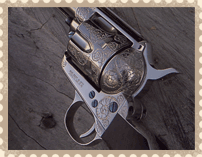
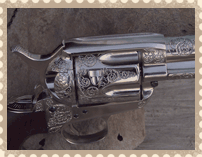
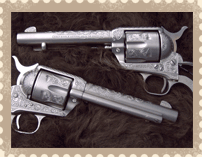
Antique Nickel
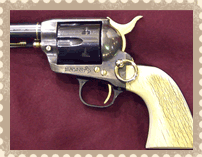
Colt SA gold plated
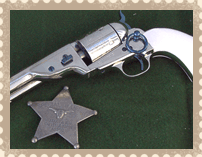
Hi polished nickel and fire blued
|






